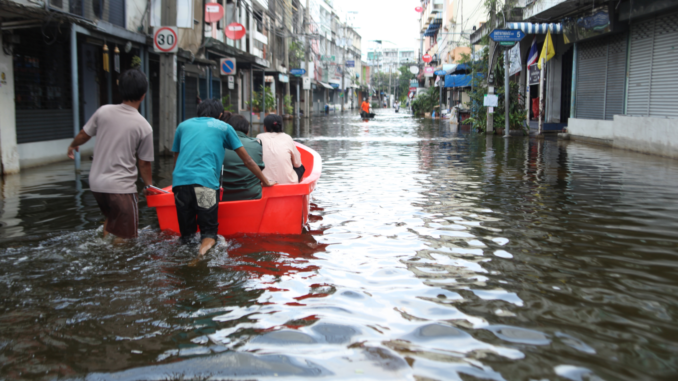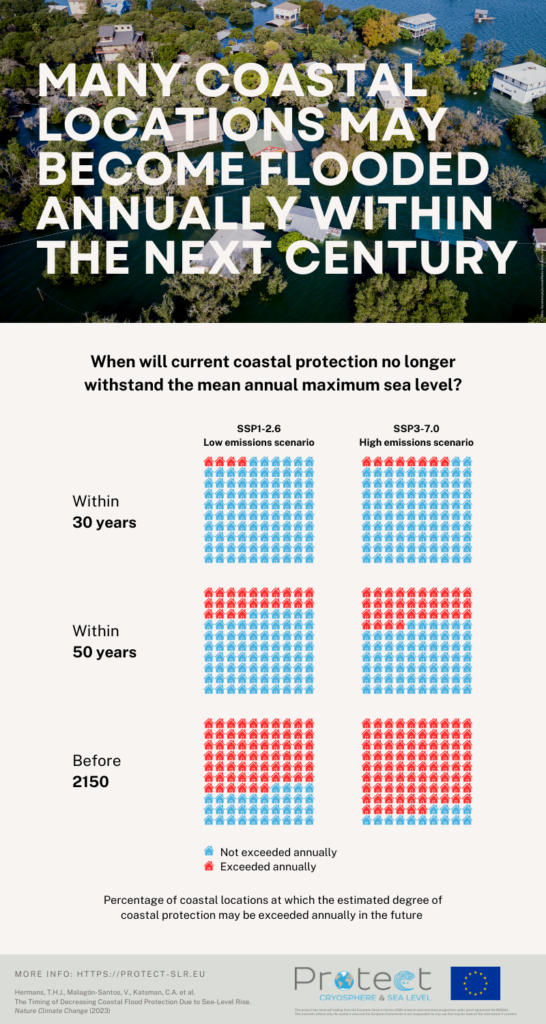
Flood risk 10 times higher in many places within 30 years
After the North Sea Flood of 1953, it took nearly 45 years to finalize the Delta Works. If we want to protect The Netherlands against sea-level rise, we shouldn’t wait too long. But how much time do we have left? An international team of researchers from Utrecht University, Deltares, and NIOZ, among others, devised a new method to calculate when we can expect a certain increase in flood probability in a specific area. The calculations show that within 30 years, the estimated probability of flooding will be 10 times higher in more than a quarter of the places studied. The researchers published their results in Nature Climate Change.
Sea-level rise is causing extremely high water levels to become more frequent. This is a problem because floods often result from extremely high water during a storm. So, the probability of disasters is increasing as the Earth continues to warm. However, researchers did not yet know when to expect a certain increase in flood probability at specific places. That’s because protection levels vary quite a bit around the world (see “Different degrees of protections” below). So, in this study, researchers devised a new method to calculate when we can expect a certain increase in flood probability in a specific area. They then applied this method to nearly 500 places around the world.

Little time
The calculations show that in more than a quarter of those places, the estimated probability of flooding will be 10 times higher within the next 30 years. Estimates are used because the probability of flooding is not exactly known at all places. The increase is most rapid in central America, southern Europe, South Africa and parts of Asia and Australia. To counteract this increased risk, coastal defences will have to be adjusted in time. “Generally, this is bad news,” says Tim Hermans, a climate researcher at Utrecht University, “because in some places there is little time left to take adaptive measures.”
Flood probability in Den Helder
A place also included in the calculations is the Dutch province of North Holland. The standard for the coastal defences near the city of Den Helder is a probability of flooding at a water level that now occurs only once every thousand years. The new method shows that in the year 2116, this water level will occur 100 times more often on average due to sea-level rise. The probability of flooding near Den Helder therefore becomes much higher. Hermans adds: “We have to take into account that this point could even be reached in the year 2067. This is because uncertainties of the observed water levels and the expected sea-level rise are included in the calculations.”
Measures take time
According to the researchers, knowing when a certain increase in flood probability will be reached is very important. Marjolijn Haasnoot, climate adaptation expert at Deltares and Utrecht University: “Planning and realising new adaptation measures takes time. For example, it took decades to realise the Delta Works after the North Sea Flood of 1953, even though the plans were there already,” she says. “Our new calculations give policymakers insight into how much time is left to realise new measures in different places. That is important information for planning adaptation.”
Flexible plans
“Especially in scenarios in which we continue to emit a lot of greenhouse gases, the decline in the degree of coastal protection will accelerate. The time for adaptation will therefore become increasingly shorter,” says Aimée Slangen, climate researcher at NIOZ. That’s why the researchers stress the importance of making flexible adaptation plans and detecting when additional measures may need to be implemented faster. When such measures need to be taken also depends on what increases in the probability of flooding policymakers find unacceptable.
Different degrees of protection
The height of dikes and other barriers is often based on to the height of extreme water levels. The lower the probability of the extreme water level the dike can withstand, the higher the degree of protection. In the Netherlands, the standard for the probability of flooding of dikes varies considerably: in most areas on the northern coast and in Zeeland, the lower limit is a probability of flooding of once every 1,000 years, whereas the maximum probability of flooding in place near The Hague and Rotterdam is smaller, namely once every 10,000 to 30,000 years. In areas such as Zeeuws-Vlaanderen and Ameland, on the other hand, the maximum probability is higher. Worldwide, the degree of protection also varies widely.
Publication
The timing of decreasing coastal flood protection due to sea-level rise, Nature Climate Change, 23 March, 2023.
Tim H. J. Hermans, Víctor Malagón-Santos, Caroline A. Katsman, Robert A. Jane, D. J. Rasmussen, Marjolijn Haasnoot, Gregory G. Garner, Robert E. Kopp, Michael Oppenheimer, Aimée B. A. Slangen.
See the news release on the Utrecht University website here.

Leave a Reply